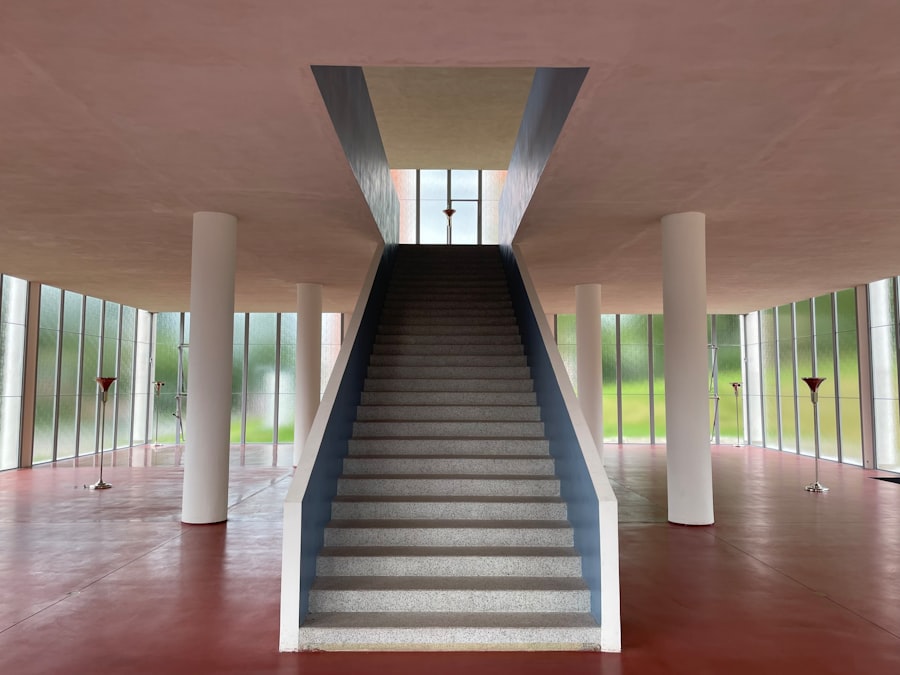The Bauhaus movement emerged in Germany in 1919, in the aftermath of the First World War. Founded by architect Walter Gropius in Weimar, the Bauhaus was a revolutionary school of art, architecture and design. It sought to unify artistic vision with practical craftsmanship, embracing modernist principles and rejecting ornate styles of the past.
The school’s philosophy emphasised functionality, simplicity and the use of new materials and technologies. Despite its relatively short lifespan, closing in 1933 due to pressure from the Nazi regime, the Bauhaus had a profound and lasting impact on 20th-century design, architecture and art education worldwide.
Summary
- Bauhaus was a German art school founded in 1919 by architect Walter Gropius
- Bauhaus design principles focused on functionality, simplicity, and the use of modern materials
- Influential figures at Bauhaus included artists and designers such as Wassily Kandinsky and Marcel Breuer
- Bauhaus had a significant impact on modern design, influencing everything from architecture to graphic design
- Bauhaus architecture and interior design emphasised open floor plans, geometric shapes, and minimal decoration
It was founded by architect Walter Gropius, who aimed to create a new type of art school that would combine fine arts, crafts, and technology. The name “Bauhaus” is derived from the German words “bau” (to build) and “haus” (house), reflecting the movement’s focus on the unity of art, craft, and technology in the design and construction of buildings and everyday objects. The school was established in Weimar, Germany, and later moved to Dessau and then Berlin before it was ultimately closed by the Nazi regime in 1933.
Innovative Education
The Bauhaus school offered a wide range of workshops in areas such as metalworking, woodworking, weaving, pottery, and typography, with the goal of training students to become versatile designers capable of working across different disciplines.
Emphasis on Experimentation
The school’s emphasis on experimentation, innovation, and collaboration laid the foundation for a new approach to design that would have a lasting impact on the world of art and architecture.
Lasting Legacy
The Bauhaus movement’s focus on functionality, simplicity, and accessibility has had a profound influence on modern design, shaping the way we think about art, architecture, and design today.
Key Principles of Bauhaus Design

The key principles of Bauhaus design can be summed up in the famous phrase “form follows function.” This principle, attributed to American architect Louis Sullivan, encapsulates the Bauhaus philosophy that the design of an object should be determined by its intended function. This emphasis on functionality and practicality led to the creation of simple, geometric forms and clean lines that became hallmarks of Bauhaus design. The movement also embraced the use of modern materials such as steel, glass, and concrete, as well as new manufacturing techniques that allowed for mass production.
Another key principle of Bauhaus design is the idea of “truth to materials,” which emphasises the honest use of materials in their natural state without unnecessary ornamentation or decoration. This approach reflects the Bauhaus commitment to simplicity, clarity, and efficiency in design. The movement also sought to create a sense of harmony between form and function, rejecting the idea of ornamentation for its own sake in favour of a more rational and practical approach to design.
These principles were reflected in the work of Bauhaus designers across various disciplines, from architecture and furniture design to graphic design and typography.
Bauhaus Masters and Influential Figures
The Bauhaus school attracted a diverse group of influential figures who played a key role in shaping the movement and its legacy. One of the most prominent figures associated with Bauhaus is Walter Gropius, who served as the school’s first director and was instrumental in defining its vision and principles. Gropius was a visionary architect and designer who sought to create a new type of art school that would integrate art, craft, and technology in a holistic approach to design.
Another influential figure associated with Bauhaus is artist Wassily Kandinsky, who taught at the school and played a key role in developing its curriculum. Kandinsky was a pioneer of abstract art and a leading figure in the development of modern art theory. His work at Bauhaus helped to shape the school’s approach to colour theory, composition, and abstraction, and his influence can be seen in the work of many Bauhaus artists and designers.
Other notable masters associated with Bauhaus include architect Ludwig Mies van der Rohe, who succeeded Gropius as the school’s director and went on to become one of the most influential architects of the 20th century. Mies van der Rohe’s minimalist approach to architecture and design had a profound impact on the development of modernist architecture, and his work continues to be celebrated for its timeless elegance and simplicity.
Impact of Bauhaus on Modern Design
The impact of Bauhaus on modern design cannot be overstated. The movement revolutionised the way we think about art, architecture, and design, and its influence can be seen in countless aspects of contemporary culture. One of the most significant contributions of Bauhaus is its emphasis on functionalism and minimalism, which has had a lasting impact on the design of everyday objects, furniture, and architecture.
Bauhaus also played a key role in shaping the development of modern graphic design and typography. The school’s emphasis on clarity, simplicity, and legibility had a profound impact on the way we think about visual communication, and its influence can be seen in everything from corporate logos to web design. The use of sans-serif typefaces, grid-based layouts, and asymmetrical compositions are all hallmarks of Bauhaus-inspired graphic design.
In addition to its impact on design aesthetics, Bauhaus also had a significant influence on the way we think about education and creative practice. The school’s interdisciplinary approach to art and design laid the foundation for a new way of thinking about creativity that continues to shape the way we teach and learn about art and design today.
Bauhaus Architecture and Interior Design

The Bauhaus Building in Dessau
One of the most famous examples of Bauhaus architecture is the Bauhaus building in Dessau, designed by Walter Gropius in 1925. The building’s sleek white façade, flat roof, and asymmetrical composition are emblematic of the Bauhaus style.
Bauhaus Interior Design
Bauhaus interior design also reflects the movement’s commitment to simplicity and functionality. The use of modern materials such as steel, glass, and concrete is common in Bauhaus interiors, as is an emphasis on open spaces, minimal furniture, and a lack of unnecessary ornamentation. The movement sought to create interiors that were practical and uncluttered, with an emphasis on clean lines and geometric forms.
Lasting Influence
The influence of Bauhaus architecture and interior design can be seen in many contemporary buildings and interiors around the world. Its emphasis on open floor plans, natural light, and modern materials continues to be celebrated for its timeless appeal and practicality.
Bauhaus in the Digital Age
In the digital age, the principles of Bauhaus design continue to have a significant impact on the way we think about technology, user experience, and visual communication. The emphasis on functionality, simplicity, and efficiency that are central to Bauhaus design are particularly relevant in the context of digital products and interfaces. The use of clean lines, geometric forms, and minimalistic layouts are all hallmarks of Bauhaus-inspired digital design.
The principles of Bauhaus design have also had a profound impact on the way we think about user experience (UX) design. The movement’s emphasis on clarity, legibility, and usability has been embraced by UX designers as they seek to create digital products that are intuitive and accessible to all. The use of grid-based layouts, sans-serif typefaces, and asymmetrical compositions are all elements that can be traced back to the influence of Bauhaus design on digital interfaces.
In addition to its impact on digital design, Bauhaus principles continue to shape the way we think about visual communication in the digital age. The use of bold colours, simple shapes, and clear typography are all elements that can be traced back to the influence of Bauhaus design on contemporary graphic design for digital platforms.
The Legacy of Bauhaus
The legacy of Bauhaus continues to be celebrated around the world for its profound impact on art, architecture, design, education, and culture. The movement’s emphasis on functionality, simplicity, and efficiency has had a lasting impact on the way we think about creativity and innovation. Its interdisciplinary approach to art and design has laid the foundation for a new way of thinking about creative practice that continues to shape contemporary culture.
Bauhaus has also had a significant impact on the way we think about education. Its emphasis on experimentation, collaboration, and hands-on learning has influenced countless art schools and design programmes around the world. The idea that art and craft should be integrated with technology in a holistic approach to creativity continues to be central to many contemporary educational programmes.
The legacy of Bauhaus can also be seen in its continued influence on contemporary art and design. Its emphasis on functionality, minimalism, and accessibility continues to inspire artists and designers around the world who seek to create work that is both innovative and practical. The movement’s commitment to creating a new aesthetic that is relevant to modern life continues to resonate with audiences today.
In conclusion, the impact of Bauhaus on modern design cannot be overstated. Its emphasis on functionality, simplicity, and efficiency has had a profound impact on art, architecture, design education, and culture. The principles of Bauhaus design continue to shape contemporary aesthetics across various disciplines from architecture to digital interfaces.
Its legacy continues to inspire artists and designers around the world who seek to create work that is both innovative and practical.
If you are interested in learning more about different art movements, you may want to check out an article on Expressionism. This artistic style, which emerged in the early 20th century, is known for its bold and emotive use of colour and form. You can read more about Expressionism here.
FAQs
What is Bauhaus?
Bauhaus was a German art school that operated from 1919 to 1933. It was known for its approach to design, which combined crafts and fine arts, and its influence on modernist architecture and design.
What were the key principles of Bauhaus?
The key principles of Bauhaus included the integration of art, craft, and technology, as well as the emphasis on functionality and simplicity in design. Bauhaus also promoted the idea of creating a total work of art, where all aspects of a building or product were designed to work together harmoniously.
Who were some of the key figures associated with Bauhaus?
Some of the key figures associated with Bauhaus include Walter Gropius, the founder of the school, as well as artists and designers such as Wassily Kandinsky, Paul Klee, and Marcel Breuer.
What was the impact of Bauhaus on design and architecture?
Bauhaus had a significant impact on design and architecture, particularly in its promotion of modernist principles such as simplicity, functionality, and the use of new materials and technologies. Its influence can be seen in a wide range of design disciplines, from furniture and graphic design to urban planning and architecture.
What is the legacy of Bauhaus today?
The legacy of Bauhaus can still be seen in contemporary design and architecture, as well as in the continued influence of its principles on art education and design practice. The Bauhaus style continues to be celebrated for its timeless and innovative approach to design.




